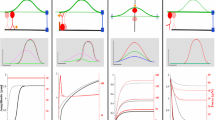Abstract
Fish melanophore cells aggregate pigment granules at the centre or redisperse them throughout the cytoplasm. The granules move along radial microtubules by means of molecular motors1–3. Cytoplasmic fragments of melanophores organize a radial array of microtubules and aggregate pigment at its centre4–7. Here we report self-centring in microsurgically produced cytoplasmic fragments of black tetra melanophores. We observed rapid (10 min) formation of a radial microtubule array after stimulation of aggregation. Arrangement of microtubules in the fragments returned to random during pigment redispersion. Apparently, formation of the radial array does not depend on a pre-existing microtubule-organizing centre. The array did not form in granule-free fragments nor in fragments treated with inhibitors of the intracellular motor protein cytoplasmic dynein. We conclude that formation of the radial microtubule array is induced by directional motion of pigment granules along microtubules and present evidence that its position is defined by interaction of microtubules with the surface.
Similar content being viewed by others
References
Schliwa, M. Mechanisms of intracellular organelle transport, in Cell and Muscle Motility (ed. Shay, J. W.) 5, 1–82 (Plenum, New York and London, 1984).
Obika, M. Cytophysiology of fish chromatophores. Zool. Sci. (Tokyo) 3, 1–11 (1986).
Haimo, L. H. & Thaler, C. D. Regulation of organelle transport: lessons from color change in fish. BioEssays 16, 727–732 (1994).
Matthews, S. Observations on pigment migration within the fish melanophore. J. Exp. Zool. 58, 471–486 (1931).
McNiven, M., Wang, M. & Porter, K. R. Microtubule polarity and the direction of pigment transport reverse simultaneously in surgically severed melanophore arms. Cell 37, 753–765 (1984).
McNiven, M. & Porter, K. R. Microtubule polarity confers direction of pigment transport in chromatophores. J. Cell Biol. 103, 1547–1555 (1986).
McNiven, M. & Porter, K. R. Organization of microtubules in centrosome-free cytoplasm. J. Cell Biol. 106, 1593–1605 (1988).
Rodionov, V. I., Gyoeva, F. K. & Gelfand, V. I. Kinesin is responsible for centrifugal movement of pigment granules in melanophores. Proc. Natl Acad. Sci. USA 88, 4956–4960 (1991).
Oakley, B. γ-Tubulin. In: Microtubules (eds Hyams, J. S. and Lloid, C. W.) 33–45 (Wiley-Liss, New York, 1994).
Doxsey, S. J., Stein, P., Evans, L., Calarco, P. & Kirschner, M. Pericentrin, a highly conserved centrosome protein involved in microtubule organization. Cell 76, 639–650 (1994).
Paschal, B. M. & Vallee, R. B. Retrograde transport by the microtubule-associated protein MAP 1C. Nature 330, 181–183 (1987).
Shpetner, H. S., Paschal, B. M. & Vallee, R. B. Characterization of microtubule-activated ATPase of brain cytoplasmic dynein (MAP 1C). J. Cell Biol. 107, 1001–1009.
Beckerle, M. C. & Porter, K. R. Inhibitors of dynein activity block intracellular transport in erythrophores. Nature 295, 701–703 (1982).
Clark, T. G. & Rosenbaum, J. L. Pigment particle translocation in detergent-permeabilized melanophores of Fundulus heteroclitus. Proc. Natl. Acad. Sci. USA 79, 4655–4659 (1982).
Vale, R. D., Reese, T. S. & Sheetz, M. P. Identification of a novel force-generating protein, kinesin, involved in microtubule-based motility. Cell 42, 39–50 (1985).
Verde, F., Berrez, J.-M., Antony, C. & Karsenti, E. Taxol-induced microtubule asters in mitotic extracts of Xenopus eggs: requirement for phosphorylated factors and cytoplasmic dynein. J. Cell Biol. 112, 1177–1187 (1991).
Heald, R., Tournebize, R., Blank, T., Sandaltzopoulos, R., Becker, P., Hyman, A. & Karsenti, E. Self-organization of microtubules into bipolar spindles around artificial chromosomes in Xenopus egg extracts. Nature 382, 420–425 (1996).
Urrutia, R., McNiven, M., Albanesi, J. P., Murphy, D. B. & Kachar, B. Purified kinesin promotes vesicle motility and induces active sliding between microtubules in vitro. Proc. Natl. Acad. Sci. USA 88, 6701–6705 (1991).
Gyoeva, F. K., Leonova, E. V., Rodionov, V. I. & Gelfand, V. I. Intermediate filaments in fish melanophores. J. Cell Sci. 88, 649–655 (1987).
Rodionov, V. I., Lim, S.-S., Gelfand, V. I. & Borisy, G. G. Microtubule dynamics in melanophores. J. Cell Biol. 126, 1455–1464 (1994).
Author information
Authors and Affiliations
Rights and permissions
About this article
Cite this article
Rodionov, V., Borisy, G. Self-centring activity of cytoplasm. Nature 386, 170–173 (1997). https://doi.org/10.1038/386170a0
Received:
Accepted:
Issue Date:
DOI: https://doi.org/10.1038/386170a0
- Springer Nature Limited
This article is cited by
-
Morphological and cytoskeleton changes in cells after EMT
Scientific Reports (2023)
-
Growth, fluctuation and switching at microtubule plus ends
Nature Reviews Molecular Cell Biology (2009)
-
Organelle positioning and cell polarity
Nature Reviews Molecular Cell Biology (2008)
-
Development-specific association of amyloplasts with microtubules in scale cells of Narcissus tazetta
Protoplasma (2007)
-
Nonlocal Mechanism of Self-Organization and Centering of Microtubule Asters
Bulletin of Mathematical Biology (2006)





